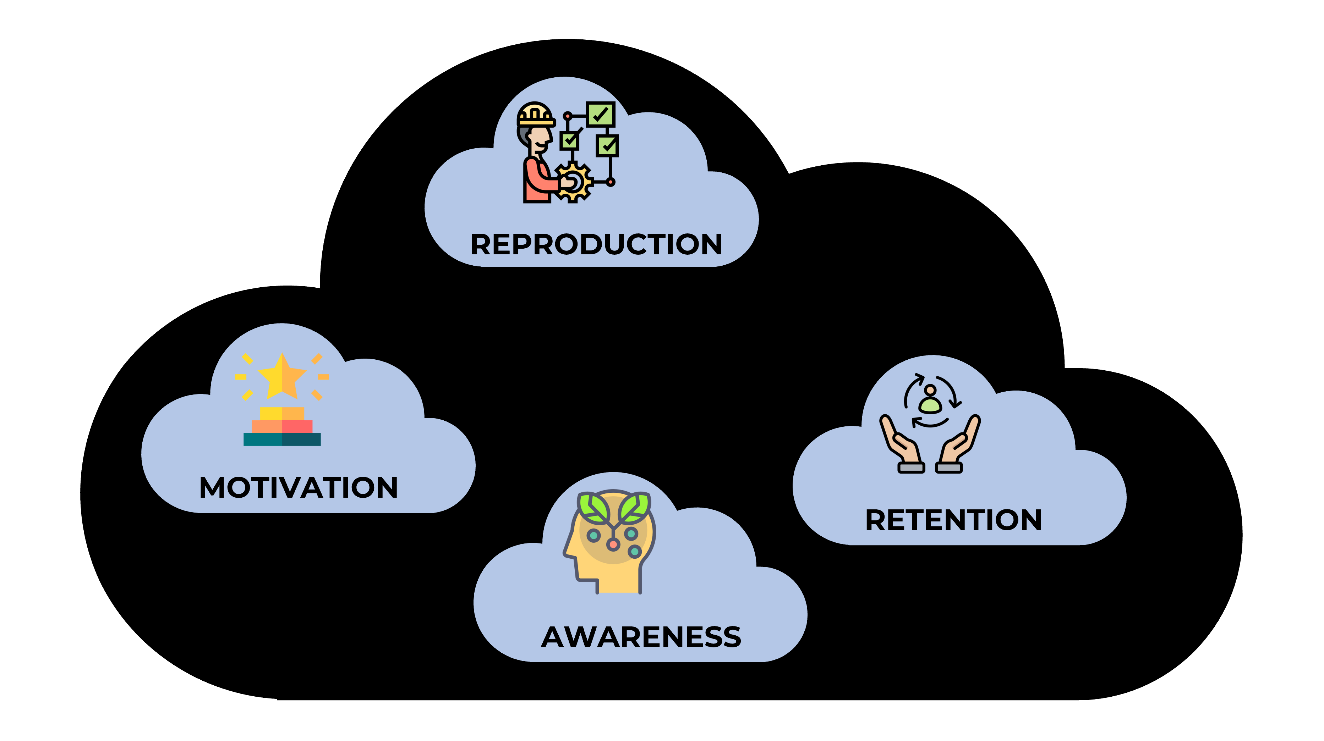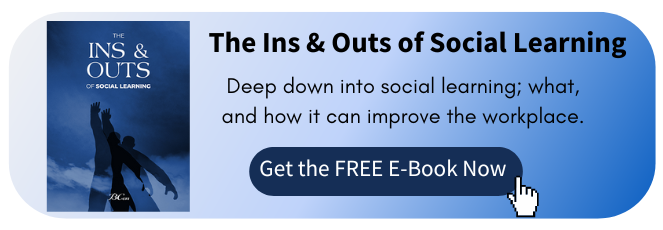Bandura's Four Processes that Influence Learning
Before we learn about the four principles of social learning developed by Albert Bandura, look at the four cards below, and attempt to put them in the correct order of the social learning process. What are your thoughts about each?

What's the order you anticipated?
Bandura's Four Processes that Influence Learning
1. Awareness
We must first observe a behavior before we can copy it. Therefore, it must be something distinctive from the rest of our surroundings. Only after then do we decide to pay closer attention to this behavior's effects.
Guide
Does any distinctive behavior among your surroundings grab your attention and you think is worth adopting and learning? (For example, to imitate a colleague who is an attentive listener, what does this person do? Look the other person in the eye, asks questions, and then summarize and paraphrase what the person is saying.)
2. Retention
Only if we recall a behavior can we imitate it. To create an accurate memory, a behavior must be observed often and possibly practiced by the learners themselves. In social learning, this point is crucial, as the secret to social learning is remembering information later and applying it in different contexts and circumstances. Without retention, we would simply lose the knowledge we have gained and become unable to use it in future contexts.
Guide
1. What are your observations about this behavior stated in the first point above?
2. Does the behavior have a set of sequences? (For example, to imitate attentive listening, you need to look the person in the eye, ask questions, and then summarize and paraphrase what the person is saying)
3. Does the behavior have consequences? (For example, when we listen attentively, others feel cared for. Hence, we develop healthy relationships with others and trust)
3. Reproduction
We must be able to do the behavior to replicate it. Even if we would like to, we cannot always physically or mentally mimic every behavior. Whether or not we are able to copy a behavior depends on our awareness of our limitations.
Guide
1. Where can you apply this behavior? In which context? (For example: applying attentive listening in the workplace and among friends and family)
2. How can you receive feedback on that behavior? (For example, asking a colleague for feedback after a meeting or encounter)
4. Motivation
The anticipated benefit of imitation ought to be compelling enough and outweigh the expense. One is more likely to adopt a new behavior the more favorable and desired the consequence is. Not everyone reacts positively to vicarious reinforcement; it should be mentioned. Some people emphasize themselves and pay less attention to the effects of other people's behavior. Such individuals are less open to social learning.
Guide
1. Why are you planning to adopt this new behavior?
2. How will life differ after its application?
3. What is pushing you forward toward applying this behavior?
4. What actions will you take after receiving criticism or when a trial goes wrong? (For example, if you received feedback that you are a poor listener, you can develop a phrase to repeat to yourself to push yourself forward "It's ok, I am still in the learning phase." You can also plan with a friend to support you when you're down.)
By now, you might be wondering how this differs from individual learning. Well, this is a valid question. For the activity above, you will do it as well as others from your organization and department as they read this e-book. You will share your learning, motivate each other, and exchange feedback. Moreover, suppose you find others who are planning to adopt attentive listening. In that case, you can form a work/community group, start learning together, sharing, giving feedback, sharing action plans, and creating follow-up WhatsApp groups, for instance.
You might be wondering about how social learning and sharing happen within an organization. Well, this usually takes place using various platforms such as social media, and various LMS systems such as UMU, and many more.
The benefits of using a social learning platform are numerous, they include but are not limited to: 2
- Social Q&A: Live Q&A can swiftly fill in information gaps as coworkers query fellow students and receive prompt responses.
- Peer Feedback Loop: Feedback that is constructive and frequent encourages learning and performance and appears less critical and more like a check-in.
- Competitive Gamification: It has been demonstrated that adding gaming aspects to tasks enhances student learning. Rewards and badges can encourage learning, while team challenges and interactive quizzes promote collaboration.
- Fosters engagement: Through social engagement, keep coworkers or the community interested in the courses and create a strong, cooperative community.
It's definitely worth mentioning that workplaces now have several formats for learning. Those vary from face-to-face formal training setups to online and social learning. Many people complain that what they miss with online learning is the human element through various interactions. One way to reintroduce the human element into learning is through blended learning, which combines in-person instruction with online learning.
Businesses can use internal social media to apply Bandura's concepts to add the human element to learning. Peer pressure is an excellent motivator, and we start to become self-motivated when we strive for greatness, and someone sees our efforts. People begin to develop networks as natural leaders (mentors) step forward to offer assistance. We retain what we learn when we supplement formal eLearning with social learning, and we can better replicate findings in the workplace. Partnerships, collaborative learning, and professional friendships can all develop through social learning.
Social learning provides a link between online instruction and in-person communication. Social learning can unite us around concepts and learning goals.3 Hence, a Social learning environment maximizes the chances for interaction among a group of learners when applied to the training field. Discussion, teamwork, experience sharing, and criticism are crucial. This is how contemporary social learning is actually defined!4
1Valamis, 10 Mar 2021, Social Learning Theory, Accessed 1 Dec 2022, https://www.valamis.com/hub/social-learning
2360 Learning, Accessed 8 Jan 2023, < https://360learning.com/blog/social-learning-platform/> Open Social, Accessed 8 Jan 2023, https://www.getopensocial.com/blog/product-center/what-social-learning-platform/
3 ELM, 15 Jan 2015, Aaron Hill, Bridging the Gap: Face-to-Face Social Learning, Accessed 11 Jan 2023, https://elmlearning.com/blog/bridging-gap-face-face-social-learning/
4 Beedeez, Accessed 11 Jan 2023, https://www.beedeez.com/en/ultimate-guides/social-learning
For more about this topic, download our latest book " The Ins & Outs of Social Learning" for FREE:
